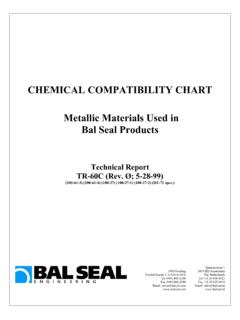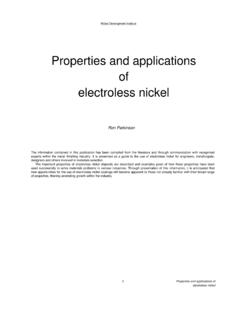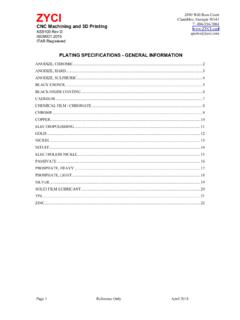Transcription of Chrome plating: A guide for ... - Bal Seal Engineering
1 Suite 901, Chinachem Century Tower178 Gloucester Road, Wanchai, Hong Kongt +852 28681860f +852 16, 5th floor1019 GW AmsterdamThe Netherlandst +31 20 638 6523f +31 20 625 PaulingFoothill Ranch, CA USA 92610-2610t +1 949 460 2100f +1 949 460 components that drive tomorrow s plating : A guide for selecting the type of Chrome plating for use in contact with Bal Seal spring-energized seals in rotary and reciprocating serviceTechnical Report TR-14 (Rev. G; 07-27-15)(100-49-2)9of2 Chrome plating : A guide for selecting the type of Chrome plating for use in contact with Bal Seal spring-energized seals in rotary and reciprocating serviceTechnical Report TR-14 (Rev.)
2 G; 07-27-15) (100-49-2)ContentsThe information, descriptions, recommendations and opinions set forth herein are offered solely for your consideration, inquiry, and verification and are not, in part or in whole, to be construed as constituting a warranty, expressed or implied, nor shall they form or be a part of the basis of any bargain with Bal Seal Engineering , If any sample or model was shown to or provided by Buyer/User, such sample or model was used merely to illustrate the general description and type of goods. Such use is not to be construed as a warranty that the goods will conform to the sample or model.
3 Furthermore, THE IMPLIED WARRANTY OF MERCHANTABILITY AND FITNESS FOR A PARTICULAR PURPOSE AND ALL OTHER WARRANTIES, IMPLIED OR EXPRESSED, ARE EXCLUDED AND SHALL NOT APPLY. This document provides product options for further investigation by Buyers/Users having technical expertise. The Buyer/User, through its own analysis and testing, is solely responsible for making the final selection of the products and for assuming that all performance, safety and warning requirements for the application are met. It is recommended that Buyers/Users run evaluation testing under actual service conditions to determine whether proposed Bal Seal Engineering products are suitable for the intended purpose.
4 Nothing contained herein or in any of our literature shall be considered a license or recommendation for any use that may infringe patent rights. (LE-17) Copyright 2016 Bal Seal Engineering , Inc. Summary ..3 Purpose of Chrome Types of Chrome Hard Chrome Thin Dense Chrome plating ..5 Electrolyzing Process Using Thin Dense Chrome Alloy ..5 Cost Specifications for Chrome plating ..5 Hard Chrome plating Specification SAE-AMS-QQ-C-320, Class Thin Dense Chrome plating Specification MIL-DTL-23422, Class 2.
5 6 Base Metal Hardness and Surface Finish Prior to plating ..6 Operating Conditions Affecting Selection of Chrome plating Methods ..7 Effects of plating on Bal Seal Spring-Energized Seal Performance ..7 Lubrication of Mating Surfaces ..7 Electroless Nickel plating as an Alternative to Chrome plating ..7 References ..99of3 Chrome plating : A guide for selecting the type of Chrome plating for use in contact with Bal Seal spring-energized seals in rotary and reciprocating serviceTechnical Report TR-14 (Rev. G; 07-27-15) (100-49-2) Summary This report outlines the types of Chrome plating available, including their advantages, disadvantages, and effects on Bal Seal spring-energized seal performance in order to make the proper Chrome plating selection for use with Bal Seal spring-energized seals in rotary and reciprocating services.
6 Thin dense Chrome plating provides superior properties over hard Chrome plating for use in contact with Bal Seal spring-energized seals in rotary and reciprocating Purpose of Chrome plating Chrome plating is generally used for one of two purposes: for decorative uses or for Engineering purposes. This report deals with the Engineering uses of Chrome plating and its effect on Bal Seal spring-energized seal performance in rotary and reciprocating services. Chrome plating is used to provide a very high degree of hardness on the surface of a metal to enhance wear resistance, reduce friction, provide anti-galling properties, and, in some cases, improve corrosion resistance.
7 Chrome plating is an electrolytic process that can be applied to regular steel, stainless steel, aluminum, and other materials. This report details the application of Chrome plating to various steel Types of Chrome plating There are two basic types of Chrome plating : hard Chrome plating and thin dense Chrome plating . Hard Chrome plating leaves a layer of Chrome from to in. (from to mm) thick on the surface of the metal. In contrast, thin dense Chrome plating has a thickness from to inch ( to mm). The thickness of Chrome plating varies depending on the application.
8 Chrome plating can be used over a wide temperature range from 70 F to 800 F ( 57 C to 427 C) and can withstand pressures up to 30,000 psi (2068 bar). The temperature and pressure limits depend on the type of Chrome plating , material substrate, and operating conditions. In most cases, thin dense Chrome plating will provide better performance because of its greater resistance to plating : A guide for selecting the type of Chrome plating for use in contact with Bal Seal spring-energized seals in rotary and reciprocating serviceTechnical Report TR-14 (Rev. G; 07-27-15) (100-49-2) in.
9 ( mm)After grinding/honingJagged StructureNodular in. ( mm)After plating , subsequent grinding/honing may not be requiredFigure section (50X) view of a hard Chrome -plated surface per SAE-AMS-QQ-C-320, Class 2E showing jagged section (50X) view of a thin dense Chrome -plated surface per MIL-DTL-23422, Class 2 showing nodular structure. Hard Chrome plating Hard Chrome plating is used in applications where parts will be subjected to a very high degree of wear, requiring a thicker layer of Chrome . The added thickness induces cracks and greater porosity on the Chrome surface.
10 The cracks increase as the Chrome thickness increases. Further machining, such as grinding, polishing, or honing, is necessary to improve the hard Chrome - plated surface so that it can be used in contact with Bal Seal spring-energized seals. A coarse surface finish significantly decreases the wear resistance of the Bal Seal spring-energized seal. Hard Chrome plating is used in approximately 95% of all applications with the remaining 5% of applications using thin dense Chrome plating (refer to Table 1 on page 8). Hard Chrome plating is generally applied to exterior surfaces where subsequent machining is easier.









